A Brush of Science
Grade 5
Presentation
Hypothesis
My big question is which brand of antiseptic mouthwash will work best to clean my toothbrush. After doing some research, I found three major brands of antiseptic mouthwash: Listerine, Colgate and Orajel. I predict that cleaning my toothbrush with Orajel mouthwash for 15 minutes will work best, because it has the highest precentage of antiseptic components (1.5%), compared to Listerine (0.194%) or Colgate (0.075%).
Research
Ways to clean your toothbrush:
Table 1: Different methods to clean a toothbrush.
|
Method |
Pros |
Cons |
|
Boiling water (30 sec) |
Gets rid of some harmful bacteria. |
Can damage the toothbrush and may burn your skin if you're not careful. |
|
UV light (5 min) |
Most effective disinfectant. |
Can damage the toothbrush and it's very expensive. |
|
Hydrogen Peroxide (15 min) |
Great at germ killing and easily accessible. |
H2O2, could be poisonous, needs to be handled with care and it needs to be done every single day. |
|
Mouthwash (15 min) |
Disinfects bacteria, cheap, simple and widely available. |
Can damage the toothbrush bristles slightly. |
Based on this information, I decided to test different types of mouthwash as the most feasible method to clean a toothbrush.
Types of mouthwash based on their function:
- Fresh breath
- Teeth whitening
- Enamel strength
- Antiseptic - a substance that prevents the growth of disease-causing microorganisms.
Most common mouthwash components:
- Cetylpyridinium chloride
- Chlorohexidine
- Essential oils (Menthol, Thymol, Eucalyptol)
- Fluoride / Sodium fluoride
- Hydrogen Peroxide
Functions of antiseptic components in mouthwash:
Table 2: Action mechanism and spectrum of different antiseptic components in mouthwash.
| Antiseptic component | Mechanism of action | Spectrum |
| Chlorohexidine (CHX) | Lower concentration is bacteriostatic (it affects the cell membrane, preventing bacterial reproduction). Higher concentration is bactericidial (cell death by cytolysis). | Bacteria, fungi and viruses. |
| Cetylpiridinium chloride (CPC) | Membrane disruption that leads to bacterial cell death. | Bacteria and yeast. |
| Essential oils (Menthol, Thymol, Eucalyptol) | Disrupts protein function in bacterua and cell membranes. | Bacteria, fungi and viruses. |
| Hydrogen Peroxide (H2O2) | Disrupts membranes, DNA and other cell components. | Bacteria, viruses and yeast. |
Common brands of antiseptic mouthwash:
- Equate: Eucalyptol, 0.092%, Menthol, 0.042%, Thymol, 0.060%
- Listerine: Eucalyptol, 0.092%, Menthol, 0.042%, Thymol, 0.060%
- Colgate: Cetylpiridinium Choride, 0.075%
- Orajel: Hydrogen Peroxide, 1.5%
→ I choose Listerine (same components as Equate), Colgate and Orajel.
How to grow bacteria at home:
- In a 16-oz measuring cup, add 10 grams of nutrient agar and 750 ml of distilled water. Stir until agar powder is dissolved.
- Heat in the microwave for 7 minutes and stir constantly.
- Carefully pour the mixture into the Petri dishes until halfway full. Replace the lid.
- Let the agar cool for 1-3 hours.
- Dip a sterile cotton swab in distilled water and swab it onto a surface. Then, trace in a gentle zigzag line onto the dishes. Clean surface and repeat.
- Place in a dark box at 37ºC for a week. Check every few days to avoid overgrowth.
- Record results. The, place in a sealed plastic bag to dispose.
How does agar work?:
Nutrient agar is made of peptone, beef extract and agar. The beef extract contains nitrogen compounds, salts, and vitamins. Peptones also offer nitrogen, specifically peptides and amino acids. Finally, agar is a gelling substance, like gelatin, but made of red algae.
Why is it called a "Petri" dish?:
It is named after Julius Richard Petri, a German bacteriologist.
What microorganisms can grow in agar?:
Bacteria, fungi and protozoa can all be cultured in agar, however viruses and archaea are nearly impossible to grow.
Contaminents in the mouth, toothbrush and bathroom:
Mouth microorganisms:
- Bacteria (Gram positive and negative cocci and rods)
- Fungi
- Viruses
- Archaea
- Protozoa
Toothbrush microbiome:
- Streptococcus
- Staphyloccus
- Lactobacilli
- Pseudomonas
- Klebsiella
- E. coli
- Candida
Bathroom microcomtaminants:
- Escherichia coli
- Salmonella
- Straphyloccus Aureus
Are all germs bad?
Not all germs are bad. In fact, the vast majority of them actually benefit us. Some things that good germs do include helping us digest our food, curdle milk to make cheese and break down natural waste.
However, there are harmful germs that can make us sick. E. coli causes diharrea, streptococcus leads to strep throat and the coronavirus results in Covid-19. While most bacteria have a bad reputation, bad bacteria only make up a small portion of bacteria in general. You can wash your hands all you want, but bacteria will still remain, and since most bacteria are helpful, it isn't such a bad thing.
How fast do germs grow?
The way bacteria reproduce is by cell division. To do so, the bacterium goes through a process called "binary fission", or dividing itself in two. The bacterium makes a copy of its DNA, splits a wall halfway through the cell, makes it two layers and the bacteria separate. This usually takes about 20 minutes.
What are the main aspects of bacteria?
They all have/are:
- Prokaryotes (nucleus-lacking organisms)
- Cell membrane
- Single-celled organisms
- DNA
- Cytoplasm
Some bacteria have:
- Pili (hair-like proteins)
- Flagellum (tail)
Bacteria can be shaped like:
- Balls (such as cocci)
- Rods (such as bacilli)
- Corkscrews (such as spirilla)
- Square (such as walsabyi)
Orthodontist interview:
Q1: Does a dirty toothbrush add more germs than it cleans?
A1: Probably not, but it's highly recommended to change your toothbrush every 3-6 months.
Q2: Does a different toothbrush bristle design impact the amount of germs cleaned?
A2: There is no scientific evidence.
Q3: What is your preferred method of cleaning your toothbrush?
A3: Replacing it works just fine, but putting it under a UV light for 5 minutes or soaking it in a prescription mouthwash with CPC (cetylpyridinium chloride) works.
What is standard deviation and how do you decrease it?
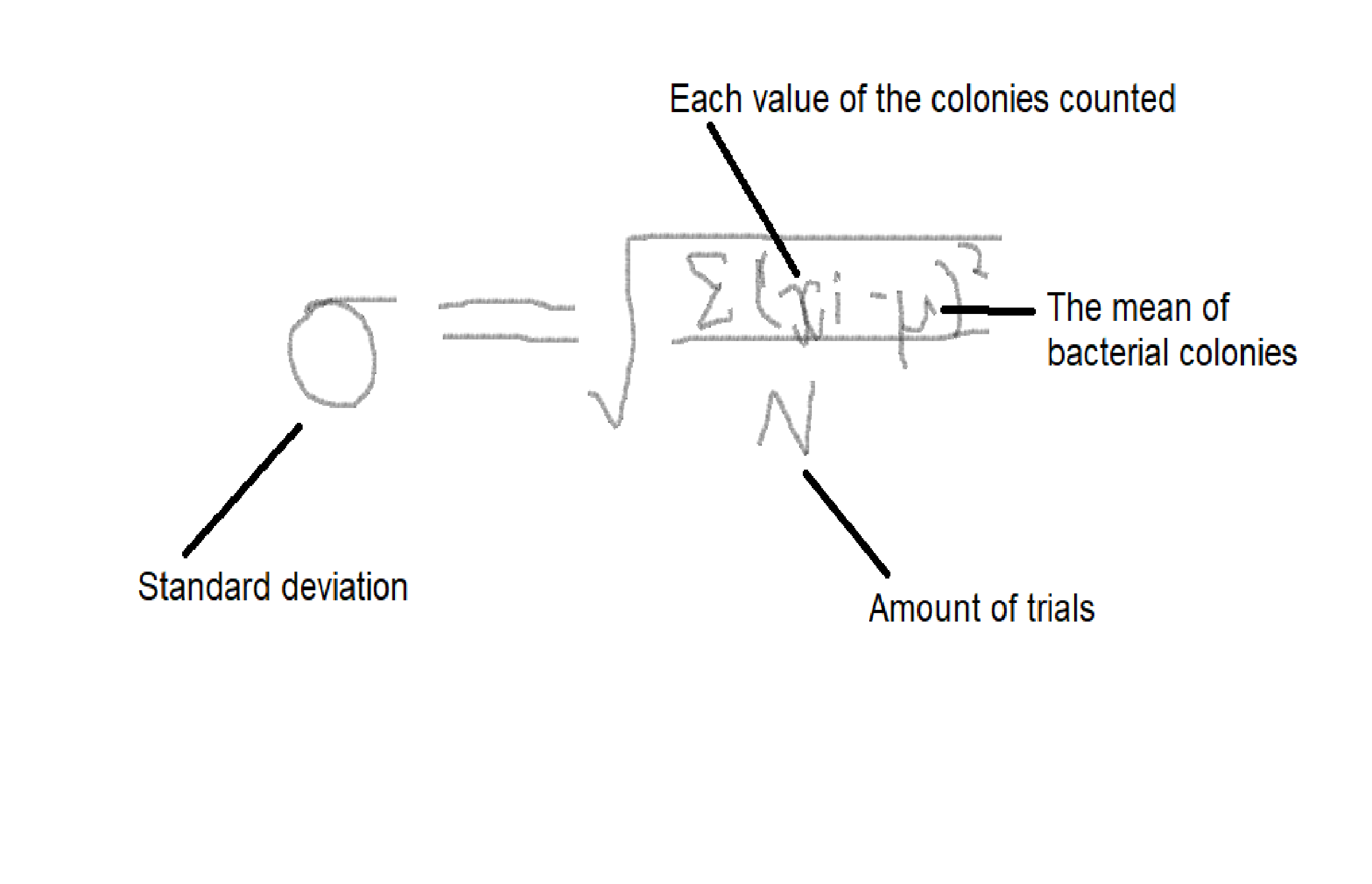
The standard deviation is the gap between the most spread-out values and the mean of the data set. To reduce this, simply increase the variable number of trials, or samples (in the formula above, you divide by a larger amount N, ergo making the standard deviation smaller).
Variables
Manipulated variable: type of mouthwash
Responding variable: number of bacterial colonies in the Petri dish
Controlled variables:
-Type of toothbrush
-Duration of cleaning (mouthwash treatment)
-Amount of mouthwash
-Brushing conditions (duration, toothpaste used)
-Rinsing conditions
-Agar preparation
-Bacterial growth (light, temperature)
Procedure
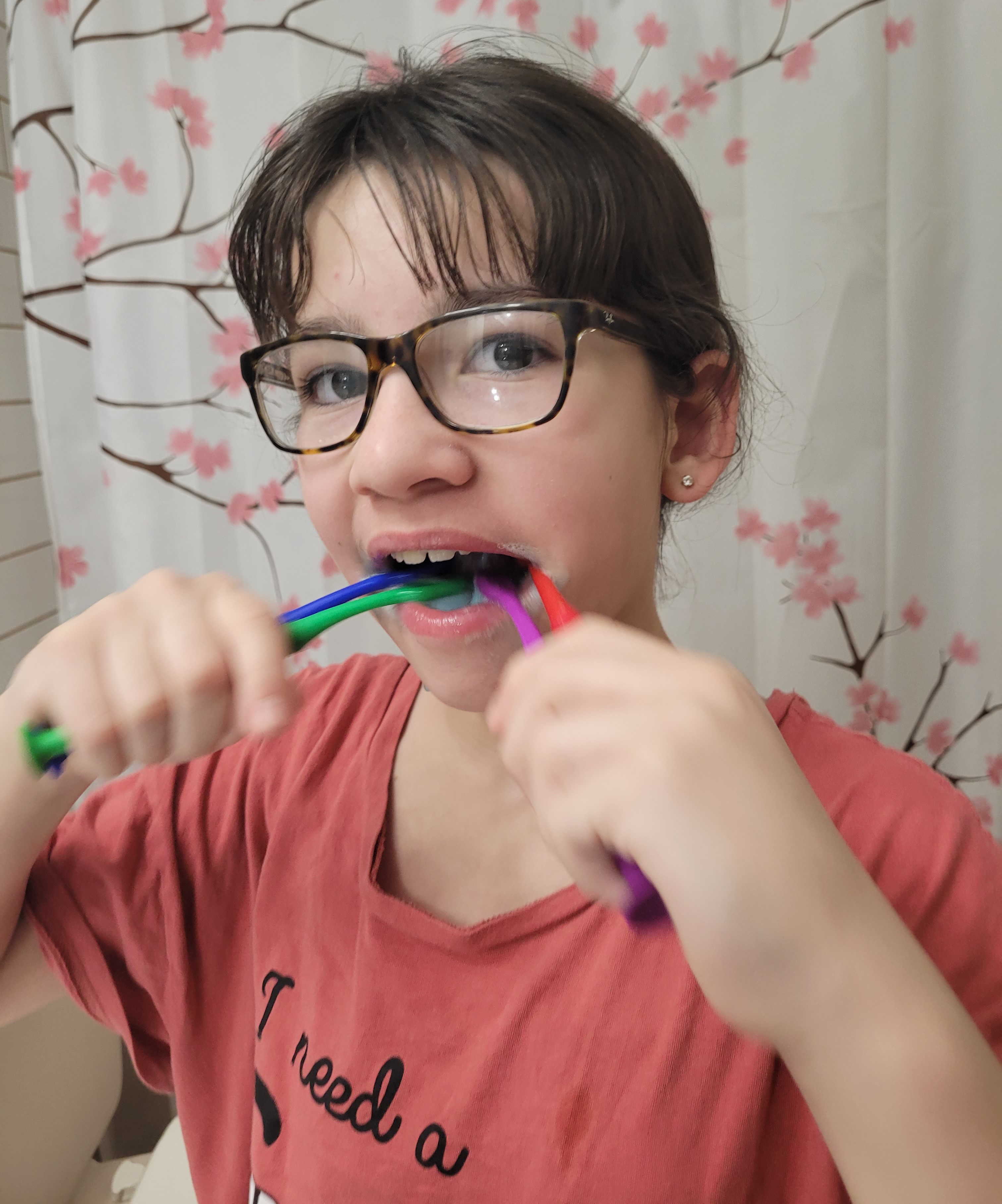
First, I will brush my teeth with 4 brushes at the same time every day for 2 minutes, with about the same amount of toothpaste on each one. After each session, I’ll rinse them with warm, running water for 30 seconds, letting them air dry in an upright position. After 1 week, I’ll use a different treatment (15 ml of antiseptic mouthwash for 15 minutes) to clean each brush:
-Brush 1: negative control (no treatment)
-Brush 2: Orajel
-Brush 3: Listerine
-Brush 4: Colgate
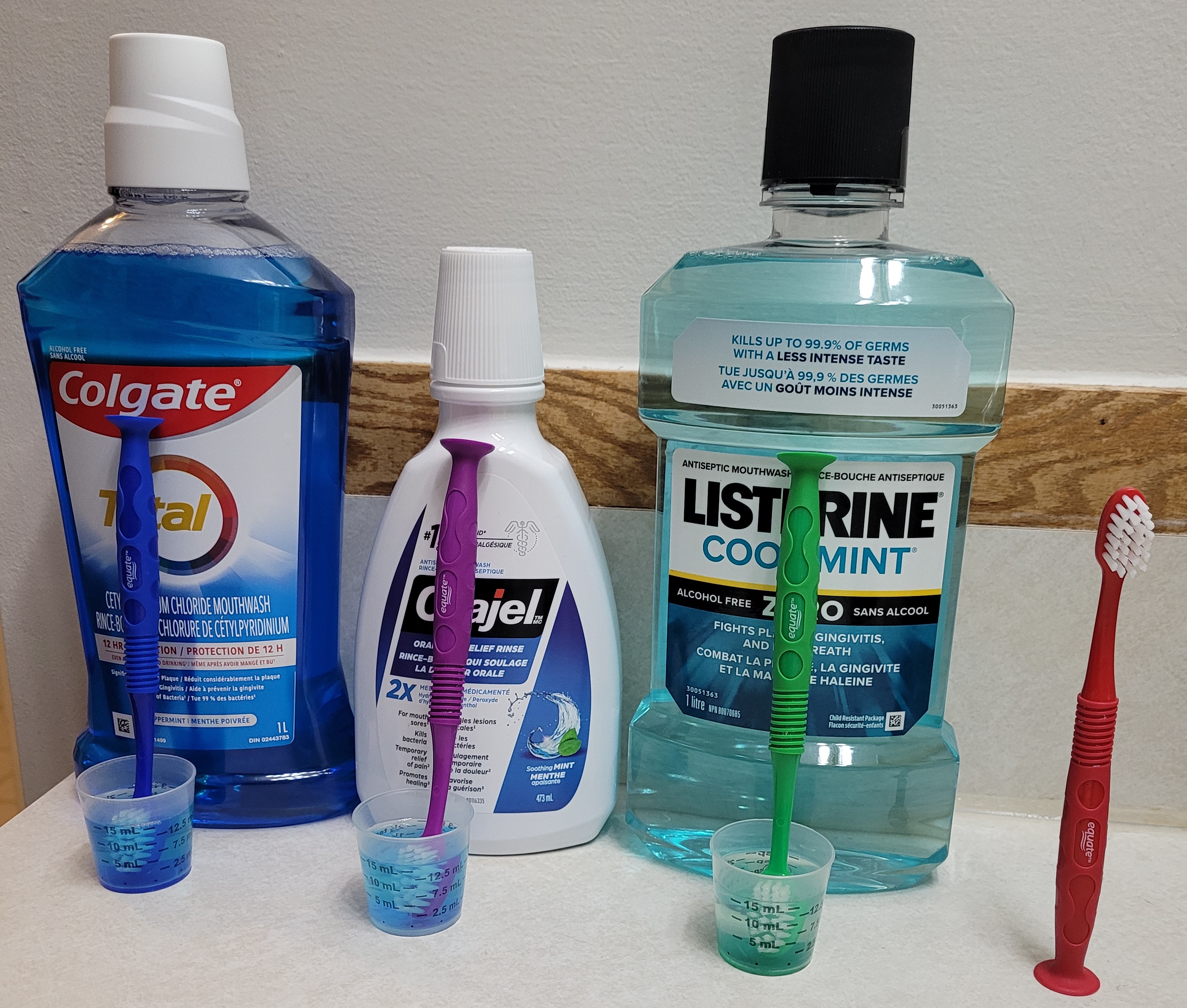
After the treatments, I will rinse the toothbrushes under warm running water for 30 seconds, letting each brush dry overnight.
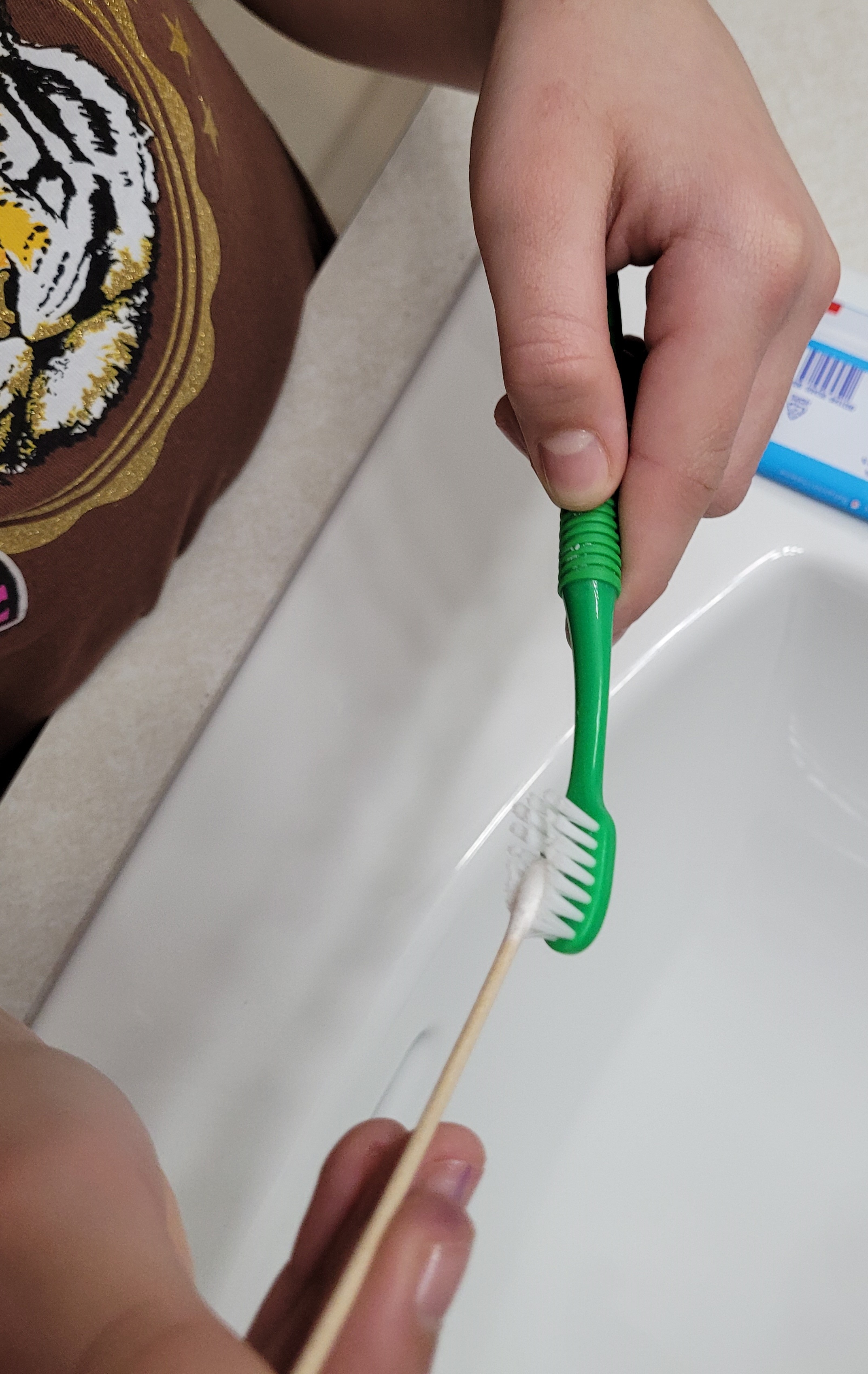
I will then swab all 4 toothbrushes with a sterile cotton swab dipped in distilled water, and culture the bacteria in a Petri dish containing agar growth medium. I will also swab a new brush for additional comparison.
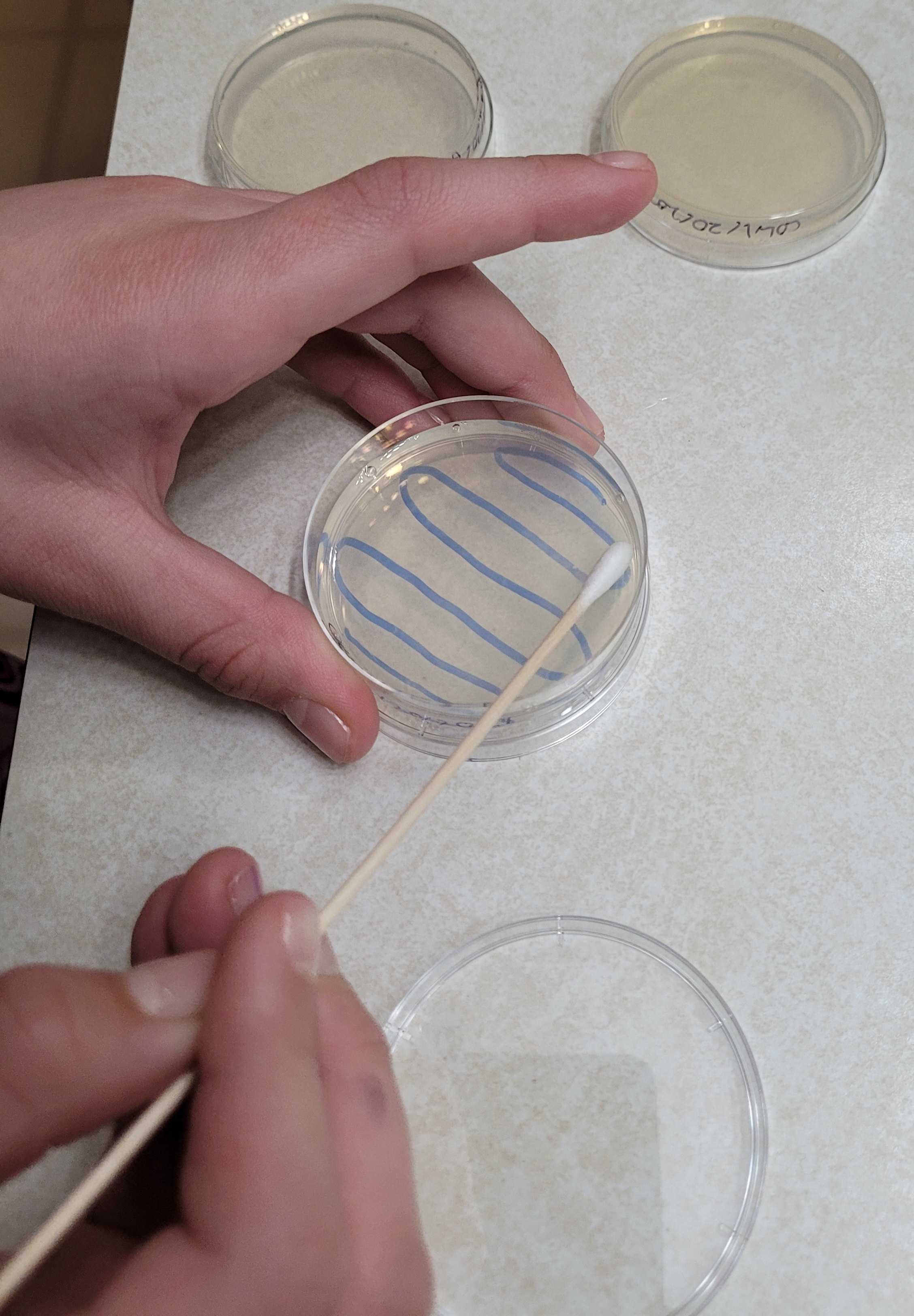
The plates will be kept in a closed box covered with a heated blanket, to keep the temperature constant (around 35ºC), for 6-7 days, to let the microorganisms grow.
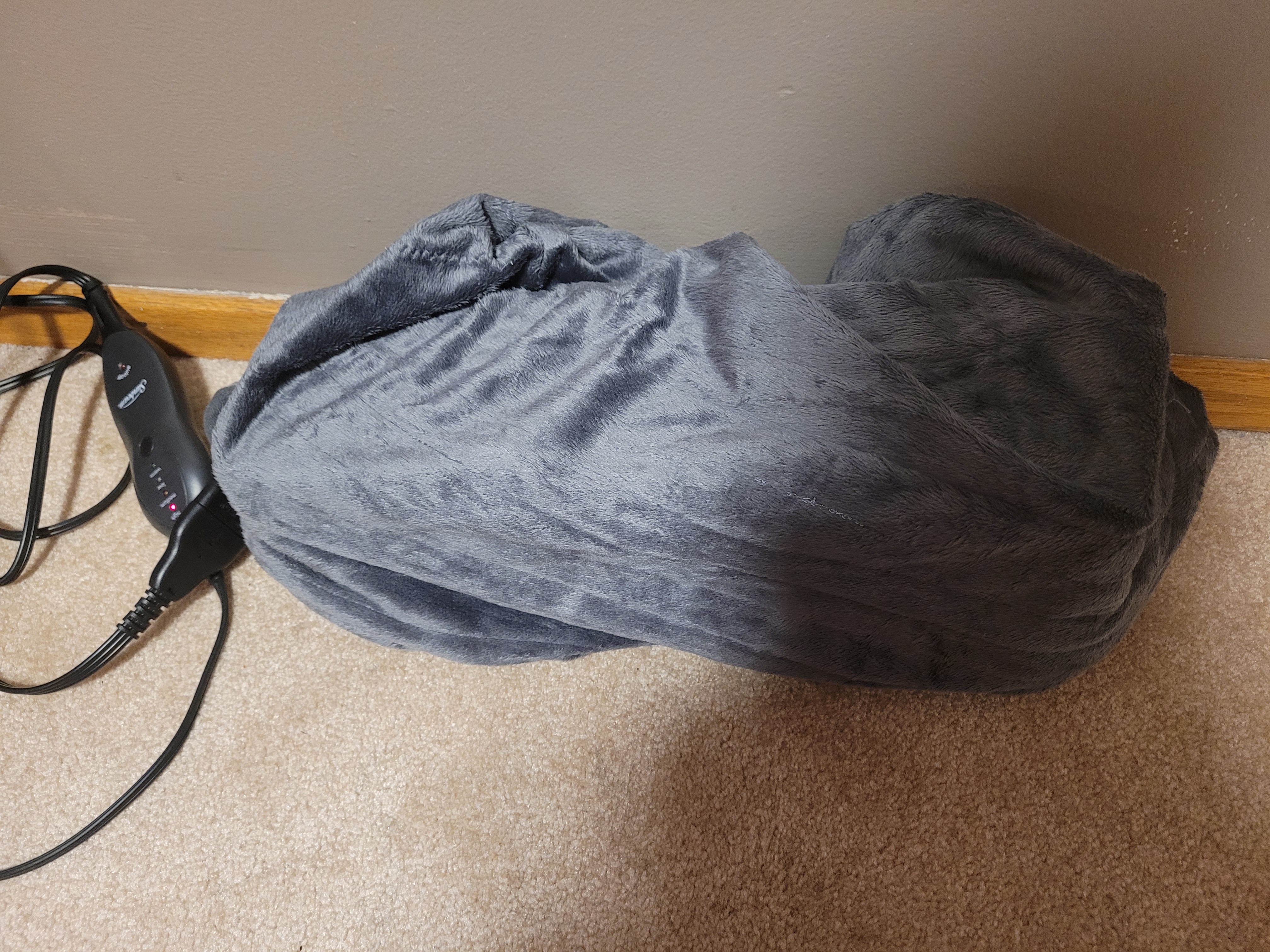
I will count the colonies to determine the effectiveness of each treatment compared to the negative control and the new brush.
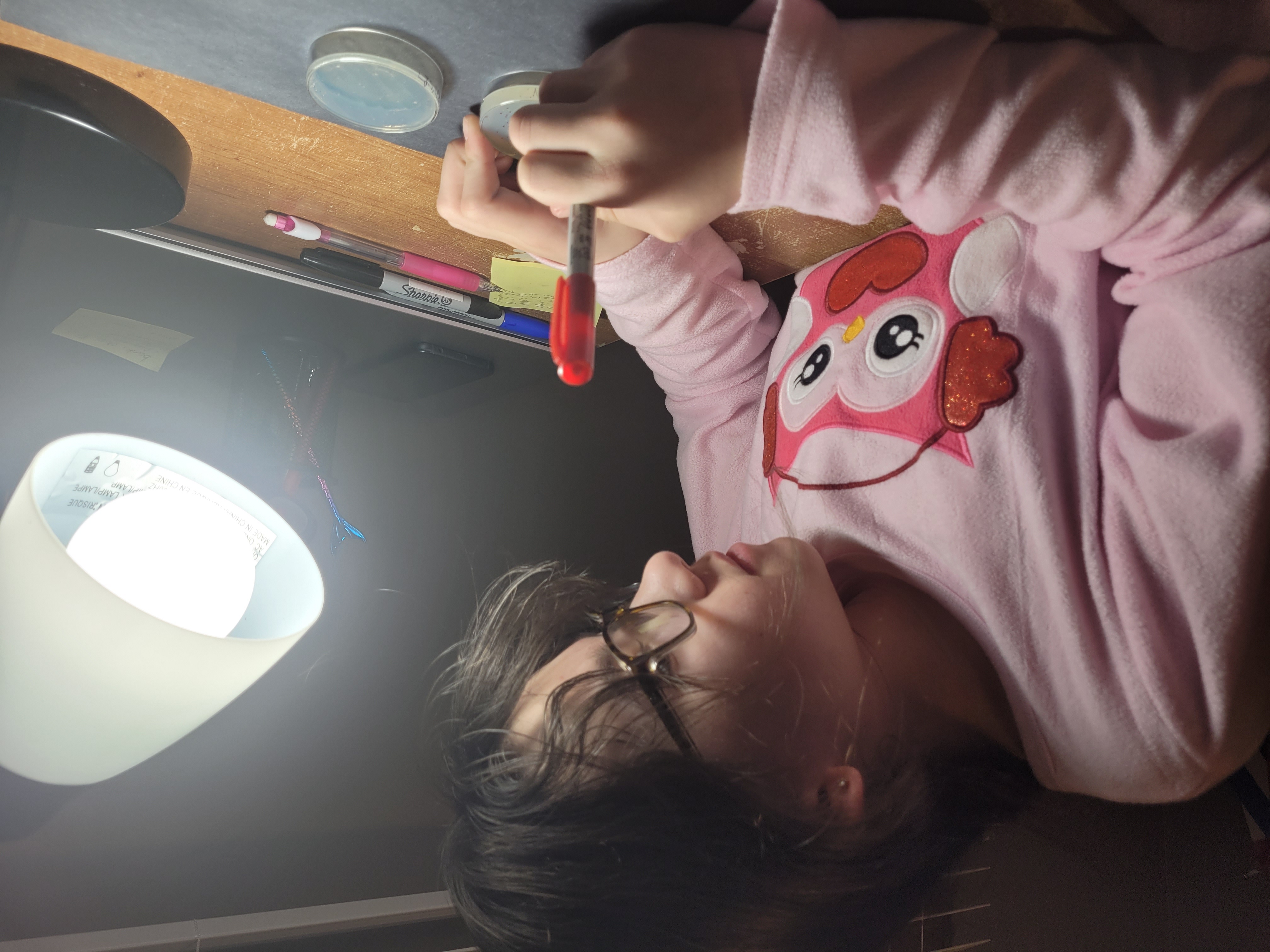
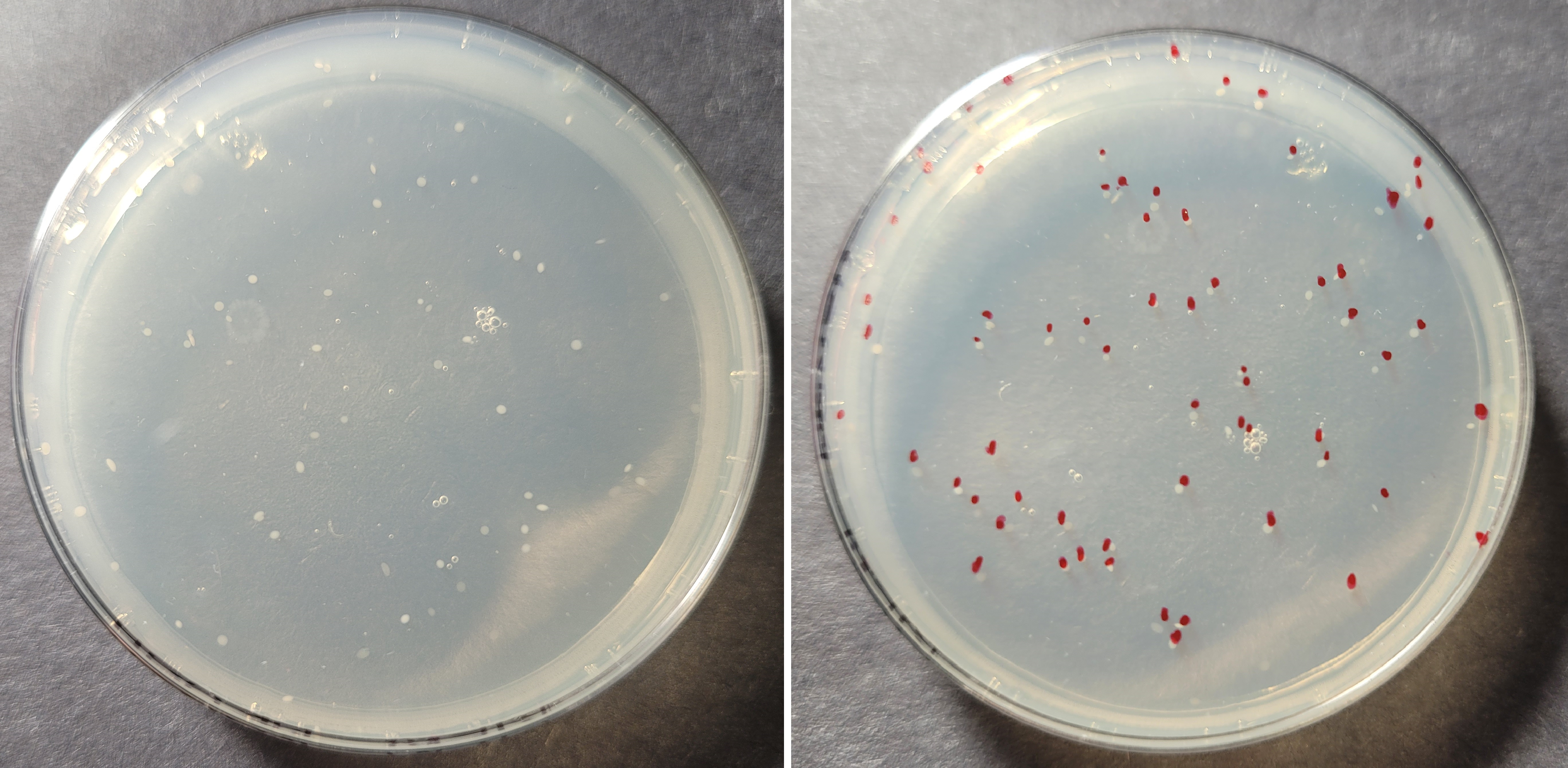
I will repeat this experiment 3 times to ensure my results’ accuracy and reliability.
Agar dish set up:
- In a 16-oz measuring cup, add 10 grams of nutrient agar and 750 ml of distilled water. Stir until agar powder is dissolved.
- Heat in the microwave for 7 minutes and stir constantly.
- Carefully pour the mixture into the Petri dishes until halfway full. Replace the lid.
- Let the agar cool for 1-3 hours.
- Keep agar plates at 4ºC until usage.
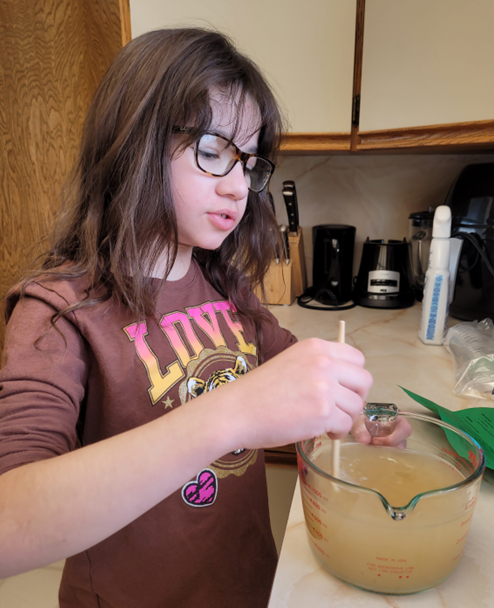
*Note: To dispose, simply close the Petri dish, seal in an airtight bag and throw away in the garbage.
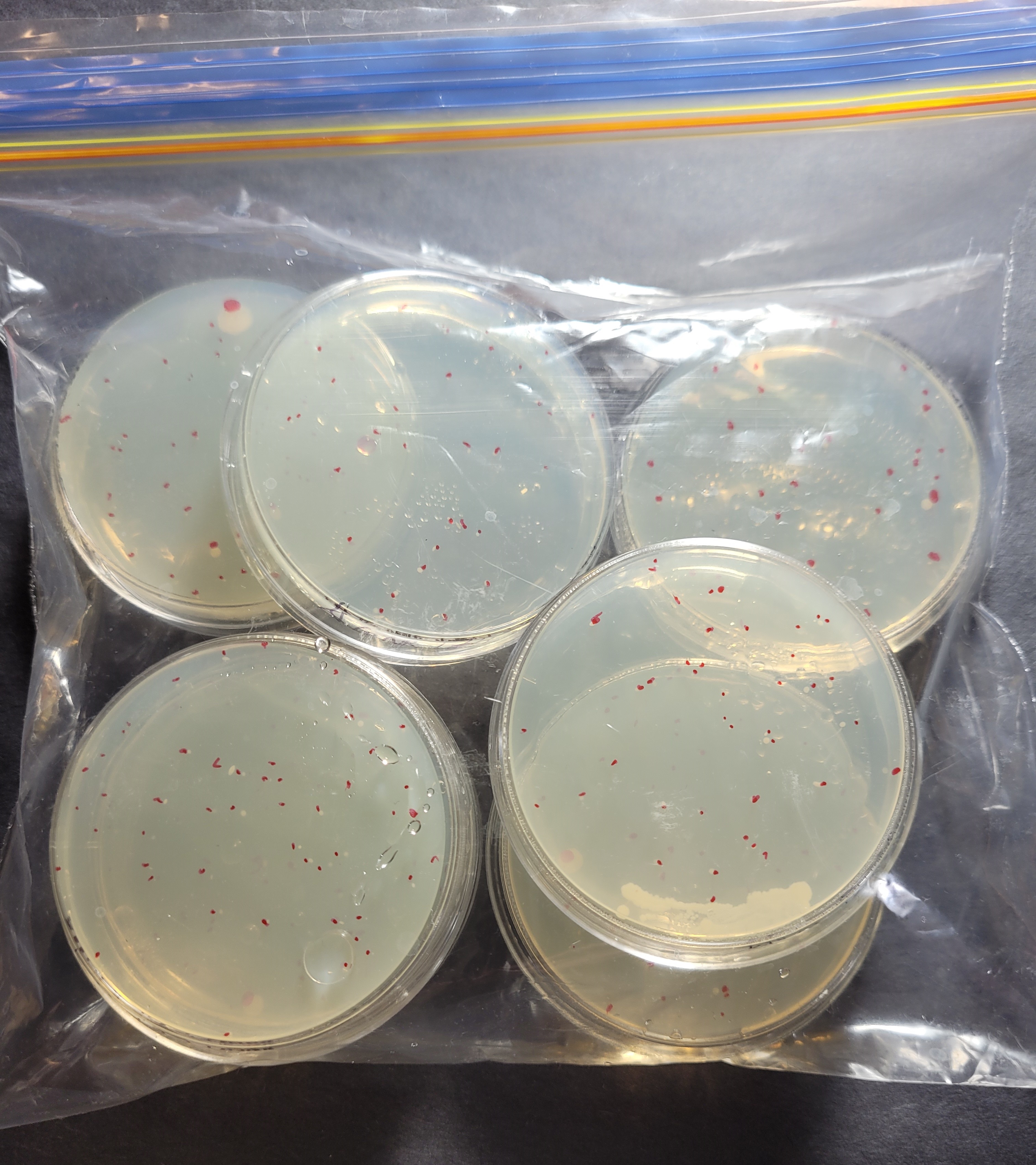
Observations
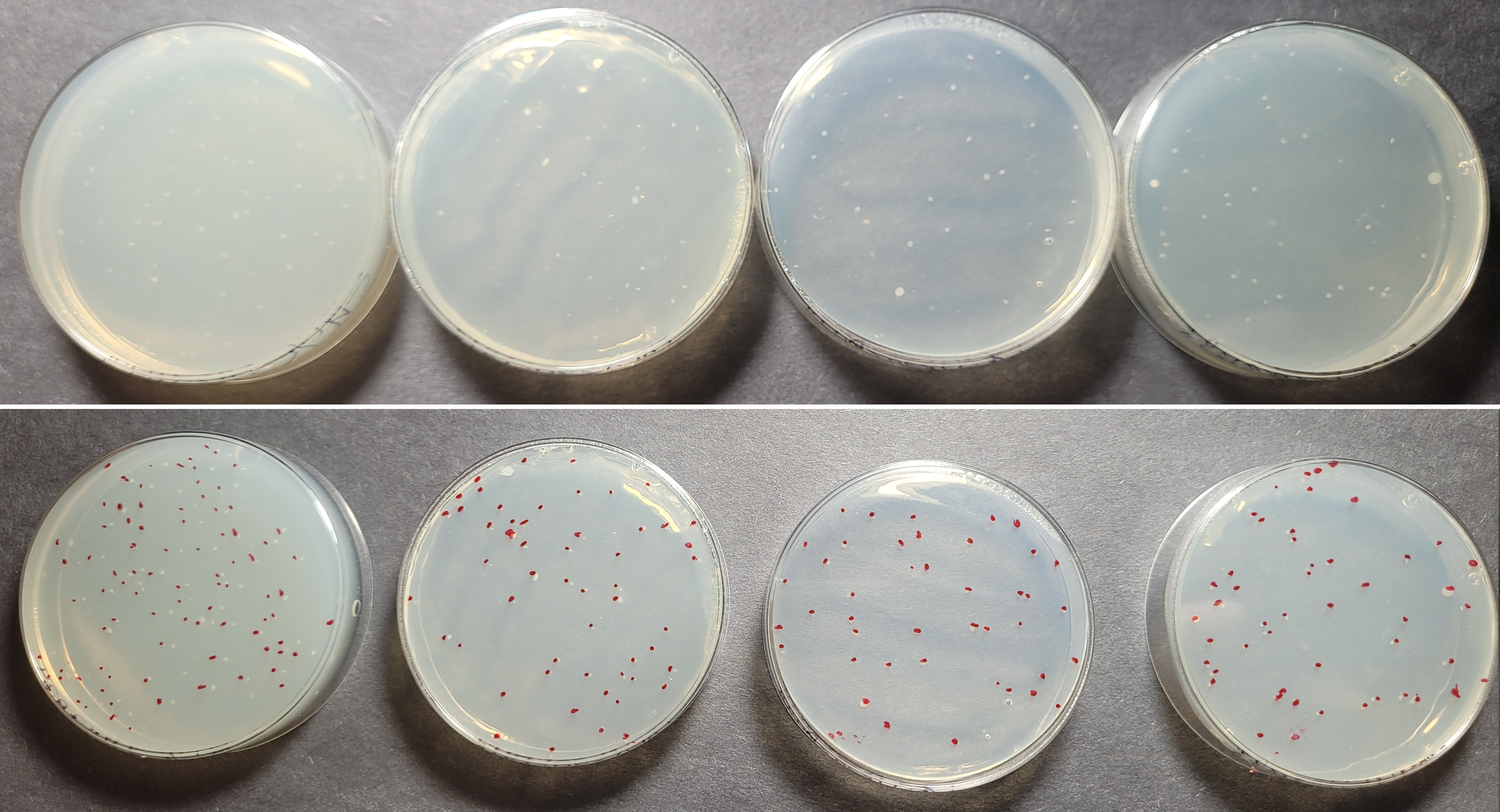
Figure 1: Example of Petri dishes after colony count.
Table 3: Number of colonies per treatment.
| Replicate | Orajel | Listerine | Colgate | Negative Control | New brush |
| 1 | 42 | 43 | 54 | 87 | 59 |
| 2 | 48 | 46 | 41 | 48 | 31 |
| 3 | 20 | 13 | 27 | 58 | 41 |
| Mean | 37 | 34 | 41 | 64 | 44 |
| SD | 15 | 18 | 14 | 20 | 14 |
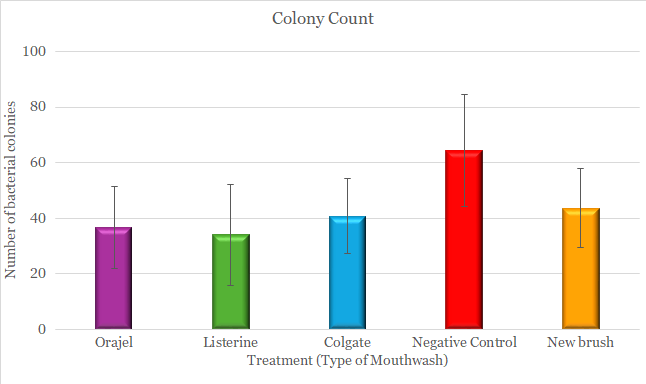
Figure 2: Number of bacterial colonies after treatment with different mouthwashes. Bars represent the mean and standard deviation of 3 replicates.
Analysis
To assess which mouthwash works best to clean my brush, I brushed my teeth with 4 brushes at the same time for 1 week. Then, I soaked each brush in a different brand of antiseptic mouthwash (and a negative control). I evaluated the effectiveness of the brand of mouthwash tested by swabbing the toothbrush and culturing the corresponding bacteria in agar plates. After a week, I counted the colonies to determine the effectiveness of each brand of mouthwash compared to the untreated brush (negative control) and a new brush (positive control). I repeated this experiment 3 times, and the mean and standard deviation are shown in Figure 2.
After doing the experiment, I can conclude that my hypothesis was incorrect. My hypothesis was that, “cleaning my toothbrush with Orajel mouthwash for 15 minutes will work best, because it has the highest percentage of antiseptic components”. However, my replicates prove that all of the mouthwashes tested had a similar effect on diminishing bacterial growth compared to the negative control. In fact, my study shows that cleaning the toothbrush with any tested mouthwash was about as successful as a new brush (which isn’t as clean as you might think!).
Although the Orajel mouthwash had the highest percentage of antiseptic components (1.5%), compared to Listerine (0.194%) or Colgate (0.075%), each mouthwash had different active ingredients. For instance, Orajel contains hydrogen peroxide, whereas Listerine has a mixture of essential oils, such as eucalyptol, menthol and thymol, and Colgate has cetylpyridinium chloride. Ergo, it is possible that the effectiveness of these compounds may vary. In other words, a lower amount of one chemical may have the same biological effect as a higher or lower amount of another. As my teacher always says, “More is not better, better is better”. This may explain, in part, why Orajel didn’t show the best results.
Another thing I noticed was that there was a large standard deviation in my test replicates. This may have also contributed to the lack of difference between the mouthwashes. Having more replicates could minimize the error bars, and allow for more accurate data.
Conclusion
A safe, common and quick way to clean your toothbrush is to soak it in mouthwash. However, not all types of mouthwash work for this job, as only antiseptic mouthwashes are intended to eliminate germs, unlike fresh breath, teeth whitening and anti-cavity mouthwashes. For instance, Listerine, Colgate and Orajel are all common brands of antiseptic mouthwash, but which one will clean my toothbrush the best?
My experiment provided three trials of evidence that any of the antiseptic mouthwashes I tested - Orajel, Listerine and Colgate - were effective at reducing the toothbrush bacteria, compared to an untreated brush. They worked to keep my brush as good as new! My hypothesis was that cleaning my toothbrush with Orajel mouthwash for 15 minutes will work best, because it has the highest precentage of antiseptic components (1.5%), compared to Listerine (0.194%) or Colgate (0.075%). This was incorrect, since all of the mouthwashes were succesful. This may be explained by the fact that there were different antiseptic components in each one, so maybe it doesn't just depend on the amount, but the quality of the ingredients to eliminate germs.
Finally, some mouthwashes may have different activity, depending on the duration of the treatment. This is why I would like to do an experiment next year, focusing on the time the mouthwash needs to function best (even though this means I have to go through the pain of brushing my teeth with four brushes again!).
Application
During this project, I observed that a new brush isn’t really as clean as you think. However, it’s cleaner than the brush you use every day, ergo it’s important to find a way to clean the brush you use. One way to achieve this is to sanitize your toothbrush with antiseptic mouthwash. This may restore your toothbrush to the level of, “as good as new”.
This experiment made it clear that using any of the antiseptic mouthwashes - Orajel, Listerine or Colgate - reduced bacterial growth on the toothbrush. Even though brushing and flossing regularly is a great start to oral hygiene, cleaning your toothbrush is also a healthy habit to keep. “Everything in the human life cycle is related to the mouth: fertility, childbirth, sleep, mental health, success in school, finding a mate, getting a job, systemic disease and aging.” (“If your mouth could talk”. Dr. Kami Hoss. April 2022). In summary, this experiment supports cleaning a toothbrush with antiseptic mouthwash as part of a better oral hygiene routine.
Sources Of Error
There were several possible sources of error in my experiment:
- There were only three replicates. This could be improved by having more replicates, which may decrease the standard deviation.
- Not all bacterial colonies were the same size. Ergo, counting the colony numbers alone was a source of error, since bigger colonies mean more bacteria, and we didn't account for that.
- Different people have different germs in their mouth; however, in this experiment, the "population" sample was only 1, so the results may vary if someone else were to do this experiment. This could be improved by repeating the experiment with a greater amount of people (increase sample size).
- The temperature wasn't always constant and optimal, due to the lack of a proper incubator. This could be avoided by keeping the petri dishes in an incubator.
Citations
Interviews:
-Dr. Jiwa. Family braces Beacon Hill. February 16, 2024.
Books:
-Nye, Bill and Zoehfeld, Kathleen. "Great big book of tiny germs". April 2006.
-Hoss, Kami."If your mouth could talk". April 2022.
-Taylor, Marianne. "Discovering the microscopic world". 2023.
-Mould, Steve. "The bacteria book". November, 2018.
-Cline-Ransom, Lesa. "Germs: fact and fiction, friends and foes". October 2022.
Online sources:
-"How to clean your toothbrush". Webmd.com. April 8, 2022. Online.
-"How to disinfect your toothbrush and keep it clean". Healthline.com. June 25, 2020. Online.
-"Types of mouthwash and their uses". Listerine-me.com. February 2023. Online.
-"Antiseptic vs antibacterial mouthwash: which should you use?". Byte.com. January 3, 2023. Online.
-"How to grow bacteria in a petri dish". Wikihow.com. June 28, 2023. Online.
-"Growing bacteria". Stevespanglerscience.com. 2023. Online.
-"How to grow bacteria and more". Homesciencetools.com. 2023. Online.
-"Germs in your bathroom: everything you need to know". Bathroomcity.co.uk. 2024. Online.
-"Nutrient agar: composition, preparation and uses". Microbiologyinfo.com. 2024. Online.
-"Nutrient agar - non-selective solid media for microbiology". Biotrend.com. 2020. Online.
-"Standard deviation". En.wikipedia.org. February 8, 2024. Online.
-"Best sellers mouthwash". Amazon.ca. February 9, 2024. Online.
Scientific articles:
-McDonnell G, Russell AD. 2001. Antiseptics and disinfectants: activity, action, and resistance. Clin Microbiol Rev. 14(1):227. PMID: 9880479
-Garrido L, Lyra P, Rodrigues J, Viana J, Mendes JJ, Barroso H. 2023 . Revisiting Oral Antiseptics, Microorganism Targets and Effectiveness. J Pers Med. 13(9):1332. doi: 10.3390/jpm13091332. PMID: 37763100
-Deo PN, Deshmukh R. 2019. Oral microbiome: Unveiling the fundamentals. J Oral Maxillofac Pathol. 23(1):122-128. doi: 10.4103/jomfp.JOMFP_304_18. PMID: 31110428
-Naik R, Ahmed Mujib BR, Telagi N, Anil BS, Spoorthi BR. 2015. Contaminated tooth brushes-potential threat to oral and general health. J Family Med Prim Care. 4(3):444-8. doi: 10.4103/2249-4863.161350. PMID: 26288790
-Mahajan M. 2021. Etymologia: Petri Dish. Emerg Infect Dis. 27(1):261. doi: 10.3201/eid2701.ET2701
-Bell G. Replicates and repeats. BMC Biol. 2016 Apr 7;14:28. doi: 10.1186/s12915-016-0254-5. PMID: 27055650; PMCID: PMC4825082.
Acknowledgement
I would like to thank Mrs. Ghosh and Ms. Riel, the Brentwood School science fair coordinators, for their guidance and willingness to answer all my (neverending) questions.
I am also grateful of Dr. Jiwa, for accepting being interviewed for my background research.
Finally, I'm thankful to my parents for providing the material resources for this project, as well as their insightful discussions.

